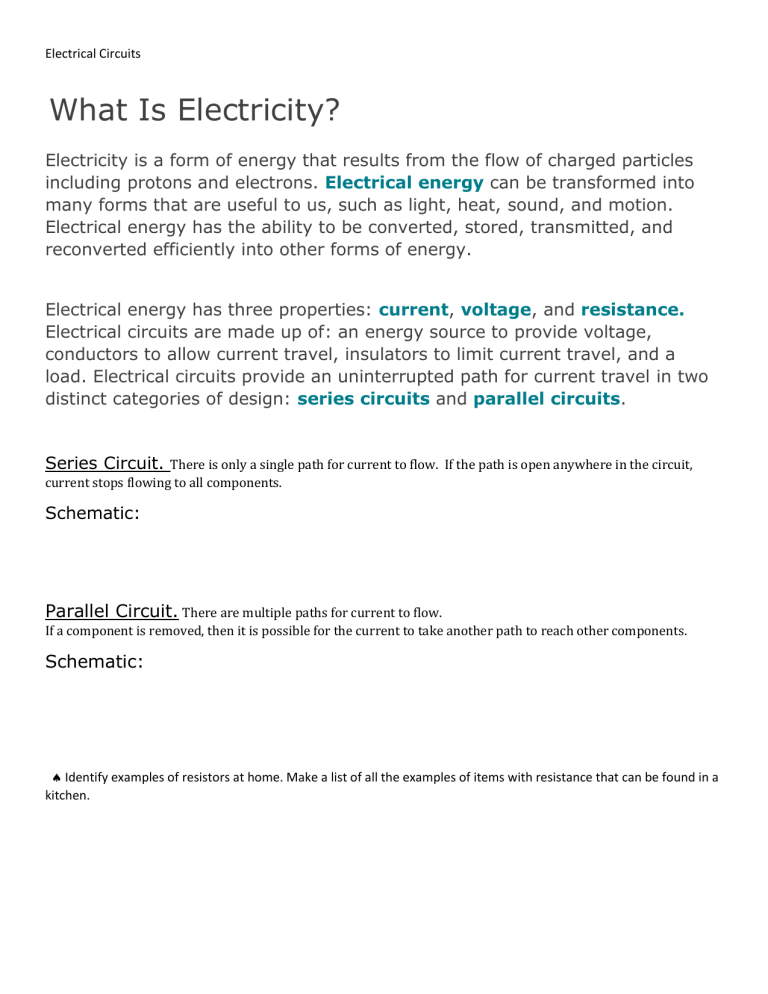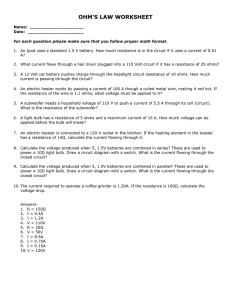
Electrical Circuits What Is Electricity? Electricity is a form of energy that results from the flow of charged particles including protons and electrons. Electrical energy can be transformed into many forms that are useful to us, such as light, heat, sound, and motion. Electrical energy has the ability to be converted, stored, transmitted, and reconverted efficiently into other forms of energy. Electrical energy has three properties: current, voltage, and resistance. Electrical circuits are made up of: an energy source to provide voltage, conductors to allow current travel, insulators to limit current travel, and a load. Electrical circuits provide an uninterrupted path for current travel in two distinct categories of design: series circuits and parallel circuits. Series Circuit. There is only a single path for current to flow. If the path is open anywhere in the circuit, current stops flowing to all components. Schematic: Parallel Circuit. There are multiple paths for current to flow. If a component is removed, then it is possible for the current to take another path to reach other components. Schematic: Identify examples of resistors at home. Make a list of all the examples of items with resistance that can be found in a kitchen. An electrical circuit is measured in voltage, current, and resistance. Quantity Abbreviation Unit Symbol Voltage Current Resistance V I R Voltage Amperes Ohms V I Two types of circuits are? Ohm’s Law Use Ohms Law to solve the word problems. Show your work. 1. An I pod uses a standard 1.5 V battery. How much resistance is in the circuit if it uses a current of 0.01 2. What current flows through a hair dryer plugged into a 110 Volt circuit if it has a resistance of 25 ohms? 3. A 12 Volt car battery pushes charge through t he headlight circuit resistance of 10 ohms. How much current is passing through the circuit? 4. An electric heater works by passing a current of 100 A though a coiled metal wire, making it red hot. If the resistance of the wire is 1.1 ohms, what voltage must be applied to it? 5. A subwoofer needs a household voltage of 110 V to push a current of 5.5 A through its coil (circuit). What is the resistance of the subwoofer? 6. A light bulb has a resistance of 5 ohms and a maximum current of 10 A. How much voltage can be applied before the bulb will break? 7. An electric toaster is connected to a 120V outlet in the kitchen. If the heating element in the toaster has a resistance of 14Ω, calculate the current flowing through it. 8. Calculate the voltage produced when 5, 1.5V batteries are combined in series? These are used to power a 10Ω light bulb. Draw a circuit diagram with a switch. What is the current flowing through the closed circuit? 9. Calculate the voltage produced when 5, 1.5V batteries are combined in parallel? These are used to power a 10Ω light bulb. Draw a circuit diagram with a switch. What is the current flowing through the closed circuit? 10.The current required to operate a coffee grinder is 1.20A. If the resistance is 100Ω, calculate the voltage drop. Ans wers: 1. R = 150Ω 2. I = 4.4A 3. I = 1.2A 4. V = 110V 5. R = 20Ω 6. V = 50V 7. I = 8.6A 8. I = 0.75A 9. I = 0.15A 10. V = 120V




